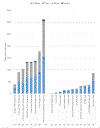Innovative playgrounds: use, physical activity, and implications for health
- PMID: 31326759
- PMCID: PMC6744323
- DOI: 10.1016/j.puhe.2019.06.002
Innovative playgrounds: use, physical activity, and implications for health
Abstract
Objectives: The aim of the study is to assess the use and levels of moderate-to-vigorous physical activity (MVPA) occurring in innovative playgrounds in London vs. traditional playgrounds in the US in neighborhoods with a similar population density.
Study design: This is a cross-sectional observational study.
Methods: We selected a sample of London playgrounds based on their innovative design. One group of eight playgrounds was matched to the US playgrounds by size and population density; a second group of very large London playgrounds was matched only by population density. Playground use and person-hours of MVPA were measured using direct observation at similar times of the day and days of the week in all locations.
Results: The number of playground visit hours was 58% higher in London than in the US (394 vs 249). The matched London playgrounds had 37.8% more children and 129% more adults who were, respectively, engaging in 90% and 116% more MVPA. While the London playgrounds were nearly 8.5 times larger than the US ones, they attracted a total of 5.8 times more visitors (1399 vs 243, P < .0001), and this included 10 times as many adults (679 vs. 66, P < .0001) and 7.5 times more seniors (23 vs. 3). The London playgrounds included more amenities targeting adults.
Conclusions: The design of an innovative playground was associated with the amount of MVPA in similar-sized playgrounds, but the size of the playground was more strongly associated with the number of visitors. It is as important to design playgrounds for adults as it is for children to increase visit hours.
Keywords: Community health; Design; Physical activity; Playgrounds.
Copyright © 2019 The Royal Society for Public Health. Published by Elsevier Ltd. All rights reserved.
Conflict of interest statement
Declaration of Interest:The authors have no conflicts of interest to disclose.
Figures
References
-
- Ding D, Kolbe-Alexander T, Nguyen B, Katzmarzyk PT, Pratt M, Lawson KD. The economic burden of physical inactivity: a systematic review and critical appraisal. British journal of sports medicine. 2017;51(19):1392–1409. - PubMed
-
- Ding D, Lawson KD, Kolbe-Alexander TL, et al. The economic burden of physical inactivity: a global analysis of major non-communicable diseases. Lancet. 2016;388(10051):1311–1324. - PubMed
-
- WorldCitiesCultureforum. % of public green space (parks and gardens) http://www.worldcitiescultureforum.com/data/of-public-green-space-parks-.... 2019.



